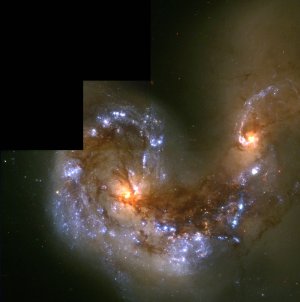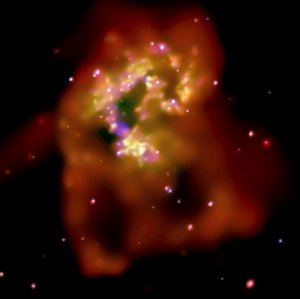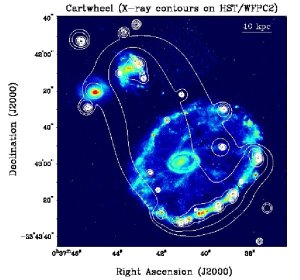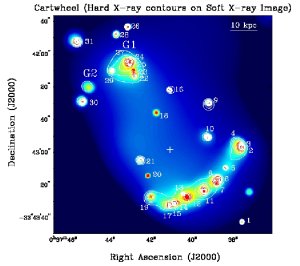
Recent X-ray observations of galaxies have uncovered a populations of sources that have high X-ray luminosities but are not coincident with the nucleus of the galaxy. They have luminosities which are greater than that possible for a normal black hole to be powering them.
There is a maximum possible luminosity of a black hole as photons carry momentum and so can exert a pressure. This means that if there are enough of them they will blow away in-falling material, which sets this maximum luminosity, and it depends on the mass of the central object. Hence astronomers know that the luminosities are too high for a black hole which has a mass a few times that of the Sun to be powering these sources. These sources are long-lived, and so they cannot be special types of supernovae for example. There are two main ideas which could explain these sources, in the assumption that they are black holes accreting from a companion star, much like X-ray binaries.
These sources are too luminous for a normal black hole - how about a more massive one? The masses required are in the region of 100 Solar Masses or more. The problem with this explanation is that there is no clear way to create black holes of this mass. Either stars could merge at the centre of clusters, faster than they evolve, so forming a very massive star, which when it dies forms a massive black hole; or black holes could merge, also at the centres of clusters. Both of these scenarios have their disadvantages, merging black holes tend to get catapulted out of the centre of the clusters and heavy stars have a very strong wind, see High Mass X-ray Binaries, and so the final black hole mass would be less than the mass of the merged stars. Surveys of some clusters show that there is some mass present that we do not see, and this could be as a result of these IMBHs.
However, what could occur is that the emission from these objects is not isotropic, but concentrated into beams, see jets. This reduces the necessity for the most massive black holes, and means that ULXs could just be special X-ray Binaries. As to why some X-ray Binaries have emission concentrated into particular directions and others do not is another matter. The other explanation is that the maximum luminosity limit is temporarily over-stepped for a few years or decades.
 |  |
| The Antennae Interacting galaxies as seen by the HST. The blue regions are where there is active star formation. (Image courtesy Hubble Space Telescope) | A similar region to that shown left as seen by the CHANDRA Satellite. Many of the point sources are ULXs. (Image courtesy CHANDRA) |
 |  |
| An optical image of the Cartwheel galaxy with the X-ray contours overlaid. The galaxy which is thought to have hit the galaxy is off the image on the right. (Image courtesy HST & CHANDRA) | The X-ray map of the same region as shown left.(Image courtesy CHANDRA) |
X-ray images of the interacting galaxies known as "The Antennae" and "The Cartwheel" show that there are large numbers of ULXs present. When galaxies collide the stars very rarely hit each other as most of space is empty, but the gas that exists between the stars does interact and the collision causes shock waves. These cause the collapse of gas clouds and new stars form. Interacting galaxies tend to have large amounts of star formation, and appear blue as the light is dominated by young massive stars. The two galaxies mentioned above show large amounts of star formation and contain many ULXs, suggesting a link between the two. This apparent connection is difficult to reconcile with the IMBH model, as the formation of IMBHs is uncertain and there is no clear reason why there should be a connection to recent star formation.
ULXs may just be a special stage in X-ray Binary evolution which are easier to form and could be expected to be connected to recent star formation as the most massive star, which forms the black hole, does not last for very long. Then either the emission is concentrated into particular directions or the luminosities are just very bright.
The Cartwheel galaxy allows astronomers to constrain these objects further, as this galaxy has a peculiar history. It was a spiral galaxy which was hit face on by another galaxy, which passed straight through it. This caused a wave of star formation to spread outwards in a ring. From the rate of expansion of the ring, and the fact that no ULXs are found inside it means that they take less than 10 million years to form and they do not last that long either - there could be thousands of dead ULXs within the ring
This is still an ongoing topic of research as these sources have only been discovered since the launch of CHANDRA and XMM-NEWTON.
BACK: X-ray Binaries UP: X-ray Research Topics NEXT: Clusters of Galaxies - Introduction